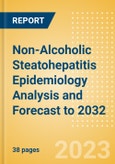1 Non-Alcoholic Steatohepatitis: Executive Summary
1.1 Catalyst
1.2 Related reports
1.3 Upcoming reports
2 Epidemiology
2.1 Disease background
2.2 Risk factors and comorbidities
2.3 Global and historical trends
2.4 7MM forecast methodology
2.4.1 Forecast assumptions and methods
2.4.2 Forecast assumptions and methods: diagnosed prevalent cases of NAFLD
2.4.3 Forecast assumptions and methods: total prevalent cases of NAFLD
2.4.4 Forecast assumptions and methods: diagnosed prevalent cases of NASH
2.4.5 Forecast assumptions and methods: diagnosed prevalent cases of NASH by fibrosis stage.
2.4.6 Forecast assumptions and methods: diagnosed prevalent cases of NASH with compensated and decompensated cirrhosis.
2.5 Epidemiological forecast for non-alcoholic steatohepatitis (2022-32)
2.5.1 Diagnosed prevalent cases of NASH.
2.5.2 Age-specific diagnosed prevalent cases of NASH
2.5.3 Sex-specific diagnosed prevalent cases of NASH
2.5.4 Diagnosed prevalent cases of NASH by fibrosis stage.
2.5.5 Diagnosed prevalent cases of cirrhosis attributable to NASH.
2.6 Discussion
2.6.1 Epidemiological forecast insight
2.6.2 Obesity omission
2.6.3 COVID-19 impact.
2.6.4 Limitations of the analysis
2.6.5 Strengths of the analysis
3 Appendix
3.1 Bibliography
3.2 Primary research - high-prescriber survey
3.3 About the Authors
3.3.1 Epidemiologist
3.3.2 Reviewers
3.3.3 Vice President of Disease Intelligence and Epidemiology
List of Tables
Table 1: Summary of newly added data types
Table 2: Summary of updated data types
Table 3: Non-alcoholic fatty liver disease activity score
Table 4: Risk factors and comorbidities for CKD
Table 5: High-prescribing physicians (non-KOLs) surveyed, by country
List of Figures
Figure 1: 7MM, diagnosed prevalent cases of NASH, both sexes, N, all ages, 2022 and 2032
Figure 2: 7MM, diagnosed prevalence of NASH, both sexes, %, all ages, 2012-32
Figure 3: 7MM, sources used to forecast the diagnosed prevalent cases of NAFLD
Figure 4: 7MM, sources used to forecast the total prevalent cases of NAFLD
Figure 5: 7MM, sources used to forecast the diagnosed prevalent cases of NASH
Figure 6: 7MM, sources used to forecast diagnosed prevalent cases of NASH by fibrosis stage
Figure 7: 7MM, sources used to forecast the diagnosed prevalent cases of NASH by cirrhosis type
Figure 8: 7MM, diagnosed prevalent cases of NASH, N, men and women, all ages, 2022
Figure 9: 7MM, diagnosed prevalent cases of NASH by age, N, men and women, 2022
Figure 10: 7MM, diagnosed prevalent cases of NASH by sex, N, all ages, 2022
Figure 11: 7MM, diagnosed prevalent cases of NASH by fibrosis stage, N, men and women, all ages, 2022
Figure 12: 7MM, diagnosed prevalent cases of cirrhosis attributable to NASH, N, men and women, all ages, 2022








